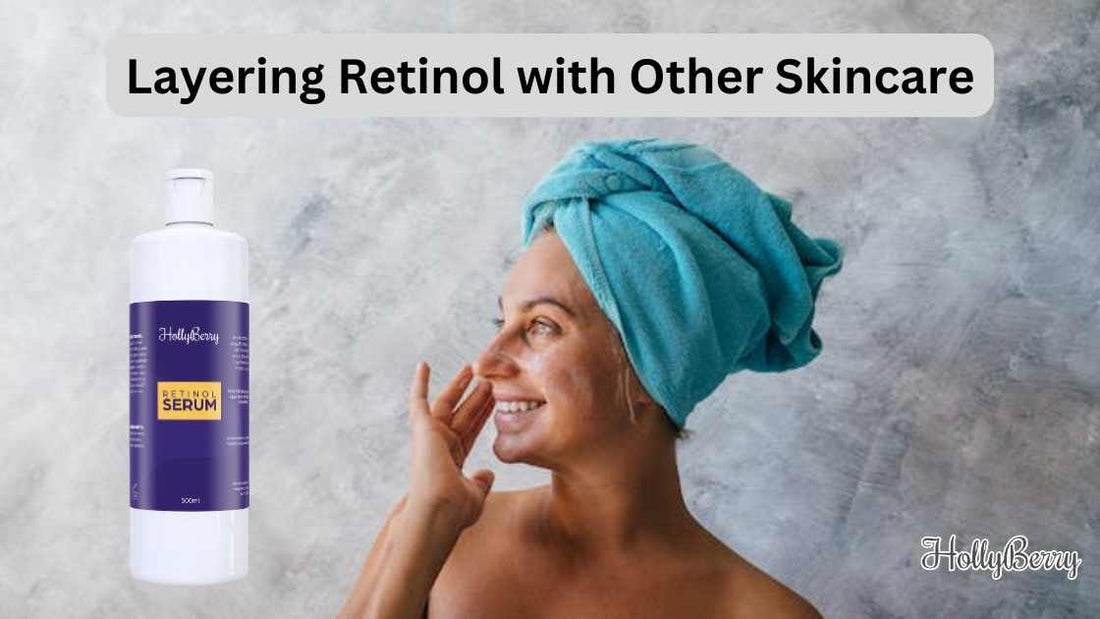
Layering Retinol with Other Skincare
Share
Maximising Benefits and Minimising Irritation

Because of its potency and its significant role in cell turnover and collagen production, understanding how to properly integrate retinol with other skincare products is vital. It is essential that users layer retinol effectively to enhance its benefits while minimising potential irritation.
Retinol works by penetrating the skin's outer layers and travelling down to the deeper layers where collagen and elastin reside, thereby promoting skin renewal from within. This unique action necessitates a methodical approach to layering, especially when combining with other active ingredients.
Certain substances, such as alpha hydroxy acids (AHAs) and vitamin C, can interact with retinol, potentially leading to increased sensitivity or reduced efficacy, so thoughtful consideration is imperative when constructing a skincare routine.
To ensure that retinol delivers its full potential, users should apply it in a manner that respects both its strengths and limitations.
This includes taking into account the other products in their regimen—particularly those that could provide complementary benefits without interfering with the retinol's performance.
Strategies, like proper spacing between the applications of different products and the use of supporting ingredients that fortify the skin's barrier, can help build a more effective and harmonious skincare routine.

Order our Retinol and Hyaluronic acid serum
Understanding Retinol
Retinol, a derivative of Vitamin A, is a quintessential ingredient in the realm of skincare, renowned for its anti-ageing and acne-fighting properties.
Benefits and Effects on Skin
Retinol serves as a powerful agent that can instigate cell turnover and boost collagen production, thereby diminishing fine lines and improving skin texture. Regular application of retinol can lead to clearer, more youthful-looking skin.
Its effects are particularly notable in reducing hyperpigmentation and accelerating the healing process of acne. The substance operates by gently exfoliating the skin, removing dead skin cells, and facilitating the renewal of skin layers.
Optimal Concentrations and Formulations
The efficacy of retinol is dependent upon its concentration and the formulation it is incorporated into. Over-the-counter products typically contain 0.25 to 1.0% retinol, suitable for daily use, whereas medical-grade options might offer higher concentrations.
Beginner users should start with lower concentrations to allow their skin to acclimate, while more tolerant skin may benefit from higher strengths. Liposomal encapsulation or other stabilising technologies are often employed to enhance the stability and penetration of retinol in skincare formulations.
The choice of concentration and formulation should align with an individual's skin type, concerns, and tolerance to prevent any potential irritation.
Methodical Layering Techniques
In establishing a regimen that includes retinol, one must carefully consider the process of layering products. Correct layering maximises efficacy and minimises potential irritation.
Preparation Before Layering
Before one begins to layer skincare products, it's crucial to start with clean skin to ensure optimal absorption. They should gently cleanse their face to remove impurities and excess oils. After cleansing, one should deploy a mild, alcohol-free toner to balance the skin's pH, which can be particularly helpful prior to applying retinol.
Sequential Application
The sequence in which one applies skincare products is as important as the products themselves. Generally, one should apply products from thinnest to thickest in consistency.
Retinol, typically found in a serum form, often should be applied after toning and before heavier creams. A waiting period of about 20 minutes is recommended after applying retinol; this allows it to fully absorb before proceeding with the next product in the routine.
Combining with Other Skincare Ingredients
One must exhibit caution when combining retinol with other active ingredients to avoid skin irritation or over-exfoliation. A key rule is to avoid vitamin C, benzoyl peroxide, and AHA or BHA acids in the same session as retinol. Hydrating ingredients like hyaluronic acid or ceramides, however, can be layered after retinol to provide moisture and bolster the skin barrier.
